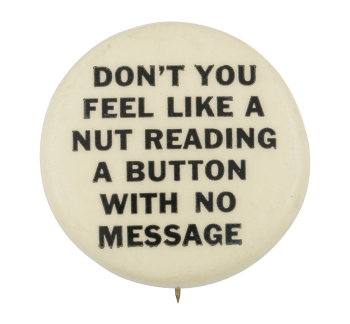| Category | |
|---|---|
| Additional Images | |
| Text on Button | Don't you feel like a nut wearing a button with no message |
| Image Description | Black text on white background. |
| Back Style | |
| The Shape | |
| The Size | |
| Year / Decade Made | |
| Additional Information | Since its modern creation in 1896 by Whitehead and Hoag, pin back buttons were used to spread messages, and to attract the attention of others; at times by declaring potentially controversial viewpoints to complete strangers. At the beginning, they were employed for political and ad campaigns for commercial products. Quickly they began to spread into other areas that included grassroot causes, activism, entertainment, music, humorous, ice breakers, self-referential, self-expressive, among other uses. The 1960s and 1970s were a prolific time for protest buttons, with examples espousing free speech, women’s rights, gay rights, sexual freedom, anti-war messages, and more. Buttons also provided the counterculture a fresh way to show off humor that expressed a less political and a more personally self-expressive point of view, as seen in this button. |
| Sources |
Carter, C. (2021, December 6). Message in a Button. JSTOR Daily. Retrieved from https://daily.jstor.org/message-in-a-button/ Carter, C. and Hake, T. (2020, November 20). The Pin-back Button Was A Place For Self Expression Before Social Media. AIGA. The Professional Association of Design. Retrieved from https://eyeondesign.aiga.org/the-pin-back-button-was-a-place-for-self-expression-before-social-media/ Oatman-Stanford, H. (2017, July 13). Pushing Buttons: In Our Divided America, Political Pinbacks Give Anyone a Voice. Collectors Weekly. Retrieved from https://www.collectorsweekly.com/articles/political-pinbacks-give-anyone-a-voice/ |
| Catalog ID | SR0008 |


